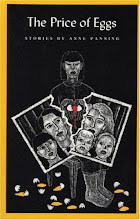
Last night after a dinner of shrimp risotto, we settled down on the couch with the kids to watch Charlie Chaplin's "The Gold Rush." I'm sort of surprised that the kids find these silent movies compelling (in fact, I'm delighted), but as the movie progressed, we found that Charlie Chaplin had later added a voice track and dialogue. This completely ruined it for us. "Awww!" we all moaned. My son, Hudson, was the most irritated. "Why do we need words?" he asked. We zoomed the volume down, but then we lost the music that provides such nice tension and pacing. My daughter, Lily, sat tucked under my arm, her feet wiggling in contentment. I kept watching her watch.
At one point, Chaplin picks the nails out of his shoes, chews the leather bits off of them, then sets them aside as if they're bones. Next, he twirls his black shoelace onto his fork like spaghetti and eats it. Lily began narrating. "Look, Charlie Chaplin is eating his shoes," she said. "He thinks his shoelace is spaghetti!" And it struck me that, as a relatively new reader, Lily is learning how to construct her own narrative from Chaplin. She is "reading" and "writing" the story in front of her by providing words to pictures.
I couldn't help think about the new Graphic Novels literature course I'm teaching. The first book we're studying is David Small's Stitches, which has been called "a silent movie masquerading as a book." Panel by panel floats by in grayscale without a word. The presentation of Detroit, Small's family living room, his parents, are delivered to us silently. It's pure synesthesia to portray silence visually. The effect is moody and hellish but ultimately beautiful. Might it work, I wondered, to bring in some Chaplin movies to the class? Might the students learn how to read graphic novels with more complexity by watching silent movies?


.jpg)
Nice post, Annie!
ReplyDeletehey found the comments! it is weird it is almost like some things are "hidden" until you roll your mouse over it...
ReplyDeleteanyway--i love the idea of H and L watching old, silent films with you and lily creating her own, unique narrative.
jianbin0901
ReplyDeletetrue religion jeans
ugg boots
ralph lauren outlet
swarovski crystal
ugg boots
fitflops sale
ray-ban sunglasses
nhl jerseys
celine outlet online
michael kors outlet
prada outlet online
rolex watches
polo ralph lauren
cartier watches for sale
mulberry handbags
ray ban sunglasses
supra shoes
nike air max
kate spade uk
longchamp outlet
louis vuitton handbags
jordan pas cher
swarovski outlet
true religion outlet
cheap canada goose jackets
louis vuitton handbags
swarovski crystal
christian louboutin online
Nice answers in return of this query with real arguments and explaining all about that.
ReplyDelete----------------------------
Best web development software Company in Kanpur
bape clothing
ReplyDeletewestbrook shoes
kevin durant shoes
curry 6
off white t shirt
gap yeezy
air jordan
hermes bag outlet
off white
supreme new york